#almendra 1970
Explore tagged Tumblr posts
Text
Final, Almendra.
7 notes
·
View notes
Text
Oda al flaco spinetta (notese la referencia jsjs) lo re extraño :’) 💚 (los clips no son míos)
#charly garcía#rock nacional#rock argentino#luis alberto spinetta#gustavo cerati#sui generis#andres calamaro#almendra#invisible#pescado rabioso#rock latino#argentina#buenos aires#rock en español#uruguay#chile#peru#colombia#latinoamerica#latino#nostalgia#1970s#1980s#progressive rock#edit#federico moura#artaud#mexico#the strokes#the new abnormal
18 notes
·
View notes
Text

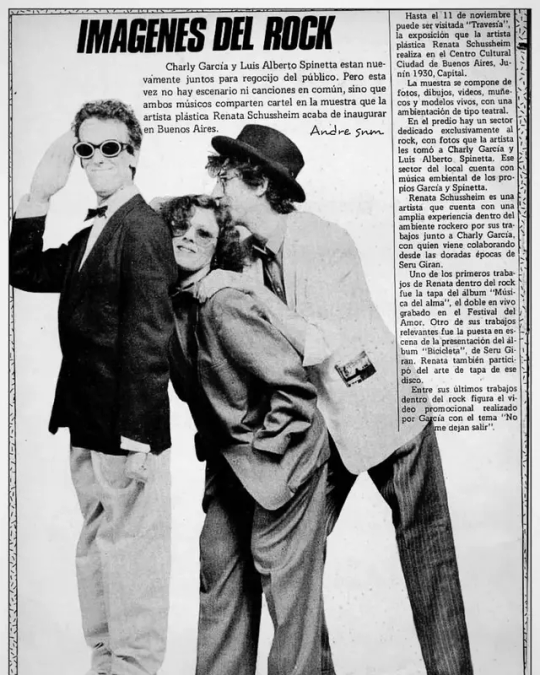
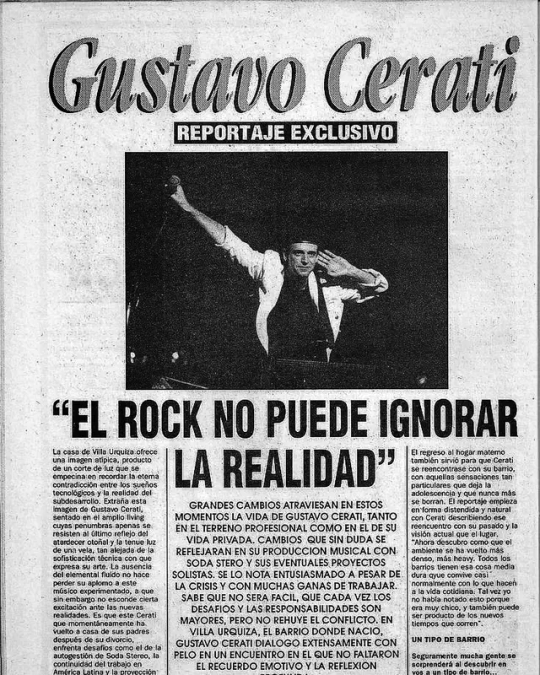

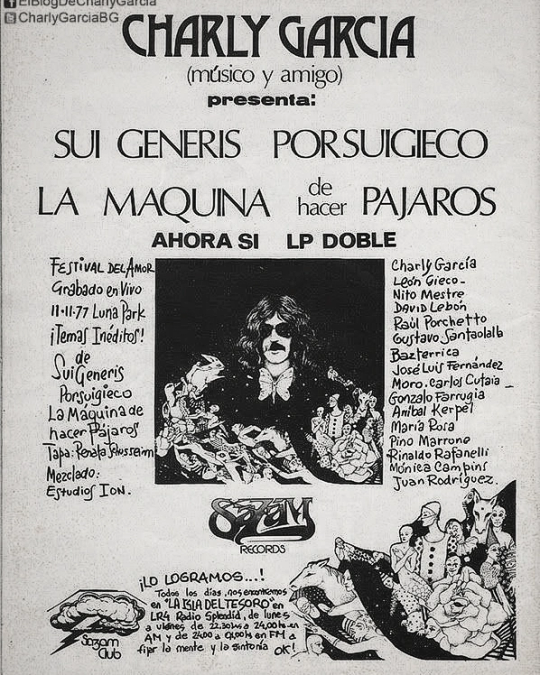
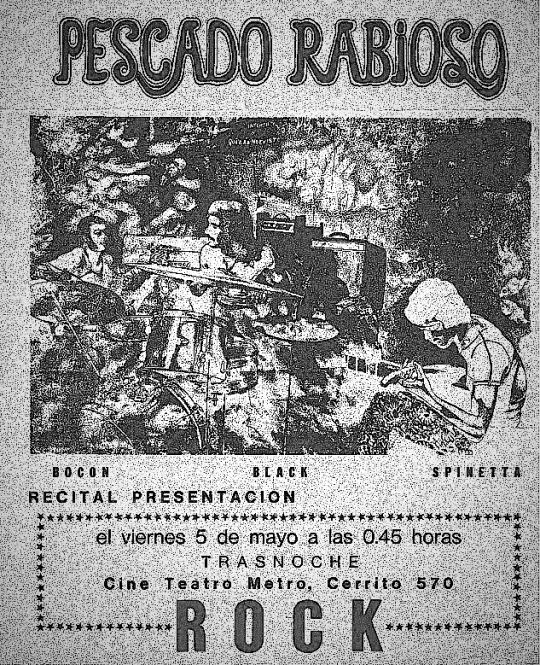
Rock nacional in magazines and posters
1. Spinetta for Pelo (1977)
2. Charly García and Spinetta
3. Gustavo Cerati (1990s)
4. Almendra (1970)
5. Charly García ( with Sui Generis, Porsuigieco and La Máquina De Hacer Pájaros)
7. Pescado Rabioso
141 notes
·
View notes
Text
LOS GATOS

LOS GATOS foi um grupo de rock argentino formado em Rosário em 1967, na esteira de um grupo anterior, Los Gatos Salvajes, que compartilhava dois membros. Eles são considerados parte da trindade fundadora do rock de língua espanhola na Argentina, junto com Almendra e Manal. O sucesso inesperado de seu single de estreia de 1967, "La balsa", foi o pontapé inicial do rock argentino. Eles exploraram o rock psicodélico e suas gravações posteriores com Pappo Napolitano são um exemplo inicial do rock progressivo, antes de se separarem em 1970. Em 1967, eles gravaram seu single de estreia "La balsa" / "Ayer nomás", que se transformou em um sucesso inesperado em grande escala, vendendo mais de 200.000 cópias, levando ao seu álbum de estreia homônimo completo no final daquele ano. Em 1968, lançaram mais um álbum homônimo e fizeram uma turnê pelo Cone Sul e, em seguida, lançaram seu terceiro álbum Seremos amigos, permeando o rock psicodélico durante seu auge. O próximo álbum da banda após um breve hiato, Beat N°1, lançado em 1969, apresentou a adição ao grupo do guitarrista Pappo Napolitano. Seu estilo de blues rock com a abordagem melódica mais clássica do vocalista Litto Nebbia tornou o álbum irregular, mas também criou passagens de música bastante deslumbrantes que podem ser consideradas uma das primeiras gravações de rock progressivo na Argentina, prevendo a ascensão do gênero na década de 70. Em 1970, Los Gatos lançou seu último álbum de estúdio. Originalmente chamado Rock de la mujer podrida (literalmente "Rock da mulher podre"), a banda foi forçada a mudar o nome do lançamento pela censura do governo para Rock de la mujer perdida, um álbum de rock mais pesado com as impressões digitais de Pappo por toda parte. Mais tarde naquele ano, Pappo deixou a banda para formar seu próprio grupo de blues-rock pesado “Pappo's Blues”. Los Gatos se desfez após um último lote de shows, com Nebbia dando início à sua carreira solo. Mais tarde, eles embarcaram em uma turnê de reunião em 2007, lançando um álbum ao vivo. O som do Los Gatos é psicodelia, blues rock, beat e pop rock. Membros: Alfredo Toth - baixo | Pappo Napolitano - guitarra | Oscar Moro -percussão, bateria | Ciro Fogliatta – piano, órgão, piano elétrico, flauta | Litto Nebbia - vocais, gaita, percussão, violão.
FONTE:
Bandas de rock relíquias
0 notes
Text
youtube
Murió Javier Martinez a los 77 años, pionero y grande del rock argentino, baterista y cantante, miembro de los Secuaces y los Beatniks ("Rebelde" con Moris) y del power trío Manal, los Cream bonaerenses. Algunos le consideran "el padre del blues argentino".
Manal era un grupo bueno y potente. Yo los conocí, sin ser consciente de ello, gracias a Tequila y Sissi. Alejo Stivel y Ariel Rot se trajeron en su vuelo transoceánico este "Necesito Un Amor" del álbum de debut de Manal (Mandioca, 1970), popularmente conocido como "el disco de la bomba", que acabó en su tercer LP "Viva! Tequila!" (Zafiro, 1980), en versión más popi- Blondie, que siempre me gustó mucho.
En su largo inicial "Matricula de Honor", Tequila ya habían recuperado "Trabajando en el Ferrocarril" - retitulada "Las Vías del Ferrocarril"- de Pappo´s Blues. Pero la canción pretequila que me parece más Tequila es "Rutas Argentinas" de Almendra.
youtube
0 notes
Text
EL FLACO

Luis Alberto Spinetta.
Artista fundamental del rock nacional, Luis Alberto Spinetta nació el 23 de enero de 1950 en el barrio de Núñez, en Buenos Aires.
Ha integrado algunos de los grupos más relevantes de Argentina, además de poseer una variada carrera solista. Desde fines de la década de los sesentas, grabó con los grupos Almendra, Pescado Rabioso, Invisible y Spinetta Jade, alternando esas etapas con la realización de discos como artista solista y una histórica reunión de Almendra.
Su primer grupo fue Almendra, formado en 1968 con tres ex-compañeros de colegio, Emilio del Guercio, Edelmiro Molinari y Rodolfo García, con quienes había tenido bandas como Los Larkins, Los Mods y Bundlemen. La primera grabación de la banda es el simple con "Tema de Pototo" y "El Mundo Entre las Manos", editado a fines del ‘68 gracias al productor discográfico Ricardo Kleinman. El grupo se presenta en vivo en Mar del Plata con Manal y Miguel Abuelo, luego viaja a un festival en Perú, y actúa el 24 de marzo de 1969 en el Instituto Di Tella.
El primer LP de Almendra sale en enero de 1970, con la famosa portada del extraño payaso y los enigmáticos símbolos de la contratapa. Años después, en sucesivas encuestas sobre la discografía del rock nacional, es votado el mejor álbum de la historia. Algunos temas son "Muchacha, Ojos de Papel", "Ana No Duerme", "Plegaria Para Un Niño Dormido" y "Color Humano". Ese mismo año, el grupo empieza a ensayar una ópera donde participarían artistas invitados de otros conjuntos, pero la obra queda inconclusa ante la separación de la banda en el mes de diciembre, poco antes de la salida de su segundo material, un álbum doble también llamado "Almendra", a secas.

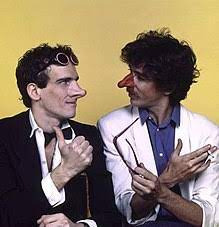
Alfaro
0 notes
Text
0 notes
Text
Hoy, en álbumes maravillosos: Almendra de Almendra (1970)

1 note
·
View note
Photo

2 notes
·
View notes
Text
Florecen los nardos
Esta es la pregunta, y yo pregunto: ¿cuál fue la pregunta? Oye, legionario, debes pasarme las manos por esta herida que no aguanto...
Almendra
23 notes
·
View notes
Text
Figuración, Almendra.
7 notes
·
View notes
Photo






Disco #163: Vox Dei - La Biblia
De Argentina he escrito acerca de varios artistas, como las bandas de Spinetta (Pescado Rabioso, Almendra, solista) y de Charly (Serú Girán), entre otras cosas, pero me quiero detener en el primer disco doble y conceptual de allá y creo que de Latinoamérica, que es el disco “La Biblia” de Vox Dei.
Un poco de contexto: Vox Dei normalmente se ha catalogado dentro de esa primera camada de bandas que armó el rock argentino, en conjunto con Los Gatos, Tanguito, Almendra y Manal. Ahora, hay veces que se les deja afuera de esa camada porque ellos hicieron lo mismo que los nombrados, a saber, rock “argentinizado”, pero eran de Quilmes y estaban alejados del centro de esa bohemia. Lo genial es que en la Argentina de 1969-1970, el rock se formaba en distintas partes y, tiempo después, se darían cuenta de ello.
La cosa es que Vox Dei sacó su primer disco en 1970 llamado “Caliente” y empezaron a preparar el segundo disco, basado en el best seller más vendido de la historia, es decir, La Biblia. Por asuntos de sello y problemas de la banda (uno de los guitarristas se fue a mitad de la grabación y el sello editó el disco antes de ser terminado), no fue de todo el gusto que querían ellos, pero aun así fue un hito por el hecho de ser el primer disco conceptual y doble, y más encima basado en La Biblia. Como alguna vez leí, solo con la insolencia de unos veinteañeros en una época de efervescencia hippie en donde cualquier cosa se puede hacer, pudo haber salido este disco.
Recuerdo haberlo escuchado en el año 2005 junto con muchas más cosas, pero aun así me sorprendió porque: uno, en lo que estaba basado; dos, hay canciones que suenan casi como de iglesia; y tres, Soda Stereo, en el unplugged, le hizo una versión a la primera canción del disco, “Génesis”, y cuando escuché este disco la reconocí de inmediato. El disco en sí es denso, pero no deja de ser muy interesante.
Después de esto, Vox Dei sacó muchos discos más y terminó siendo un referente del rock duro de Argentina, sin contar su calidad de pioneros. Ahora, ¿mejor disco? No podría decirlo, debido a que el único disco de ellos que he escuchado con la atención que se merece es éste, pero a vista de otros críticos, se dice que es el mejor o el más esencial. Igual, el concepto no es muy común en música rock (no rock pesado, claro está), y por eso, bien vale un reconocimiento.
12 notes
·
View notes
Text
almendra (1970) sooooo good album aaaughgg
1 note
·
View note
Text

El Flaco Spinetta abrazado a la muchacha ojos de papel Cristina Bustamante en un recital de Almendra en 1970.
3 notes
·
View notes
Text




Cuatro dibujos hoy viernes 8 de mayo á Tumblr con uno de The Loud House y tres del rock y metal
Lola y Lana Loud de The Loud House peleando (c) Chris Savino
Una tumba en memoria del rockero británico Brian Howe (White Sprit, Ted Nugent, Bad Company) que anteayer murió á los 66 años de edad
El baterista británico pionero del black metal Abbadon que formó parte de Venom y que el 17 de septiembre cumple 60 años de edad
La banda argentina de fines de los años 1960 y comienzos de los 1970 Almendra
#lola loud#lana loud#the loud house#loud house#tlh#que en paz descanse#queenpazdescanse#qepd#rest in peace#rip#brian howe#White Sprit#ted nugent#bad company#Bad Company band#hard rock#nwobhm#abbadon#venom#venom band#black metal#metal extremo#extreme metal#almendra#rock argentino#rock nacional argentino#rock nacional
3 notes
·
View notes


